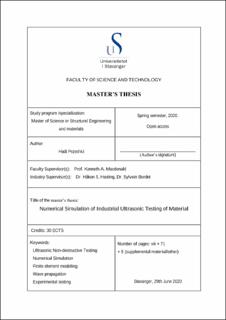| dc.contributor.advisor | Macdonald, Kenneth Jr | |
| dc.contributor.author | Pezeshki, Hadi Jr | |
| dc.date.accessioned | 2020-09-25T10:58:46Z | |
| dc.date.available | 2020-09-25T10:58:46Z | |
| dc.date.issued | 2020-06-29 | |
| dc.identifier.uri | https://hdl.handle.net/11250/2679684 | |
| dc.description | Master's thesis in Structural Engineering | en_US |
| dc.description.abstract | In this thesis, numerical simulation of ultrasonic testing is developed by modeling three different materials including Perspex, water, and steel in each model. Procedures of calibration of An angle probe including timebase calibration, probe index, and probe angle determinations are simulated by 4 different specimens. In addition, speed of sound in the three modeled media, probe near field length, time base linearity, and A-scan display were calculated and verified.
The geometry of V1, V2 calibration blocks, and a manipulated V1 calibration block were simulated in the three different models. A model with no detectable back wall echo by the probe was also created to study the noise signals generated in the simulation. An MWB60-N4 type angle probe producing an angle beam in 60 degrees in 4 MHz central frequency along with water coupling were simulated in each model. In the Results section, the nodal displacements are illustrated in magnitude and local directions that shows wave propagation through the different assembled materials.
The simulation results show that the mode change has successfully happened in the probe-coupling and coupling-specimen interfaces. An initial P-wave at the probe medium transformed into an S-wave at the specimen medium. The average speed of sound in the probe and specimen media has been verified with the analytical values. The probe near-field length was obtained at approximately 29mm which is almost the same length as proposed by the probe manufacture. The probe index is the point where the probe centerline coincides with the coupling. The angle of the probe was measured at around 58 degrees that is comparable to the nominal value of 60 degrees proposed by manufacture. Besides, A-scan displays of the models were created by using the extracted data from the simulation. The time base linearity was also verified by comparing these A-scan. The A-scan display of the simulated V2 calibration block was also compared to that of the experimental test. The comparison shows that both A-scan displays of simulation and experimental testing have a remarkable resemblance in a qualitative manner. However, the amplitude drop between the two back wall echo signals in the experimental test is significantly lower than that of the simulation. | en_US |
| dc.language.iso | eng | en_US |
| dc.publisher | University of Stavanger, Norway | en_US |
| dc.relation.ispartofseries | Masteroppgave/UIS-TN-IMBM/2020; | |
| dc.rights | Navngivelse 4.0 Internasjonal | * |
| dc.rights.uri | http://creativecommons.org/licenses/by/4.0/deed.no | * |
| dc.subject | finite element modeling | en_US |
| dc.subject | numerical simulation | en_US |
| dc.subject | wave propagation | en_US |
| dc.subject | experimental testing | en_US |
| dc.subject | ultrasonic or non-destructive testing | en_US |
| dc.subject | materialteknologi | en_US |
| dc.subject | byggkonstruksjon | en_US |
| dc.title | Numerical Simulation of Industrial Ultrasonic Testing of Material | en_US |
| dc.type | Master thesis | en_US |
| dc.subject.nsi | VDP::Teknologi: 500::Materialteknologi: 520 | en_US |

